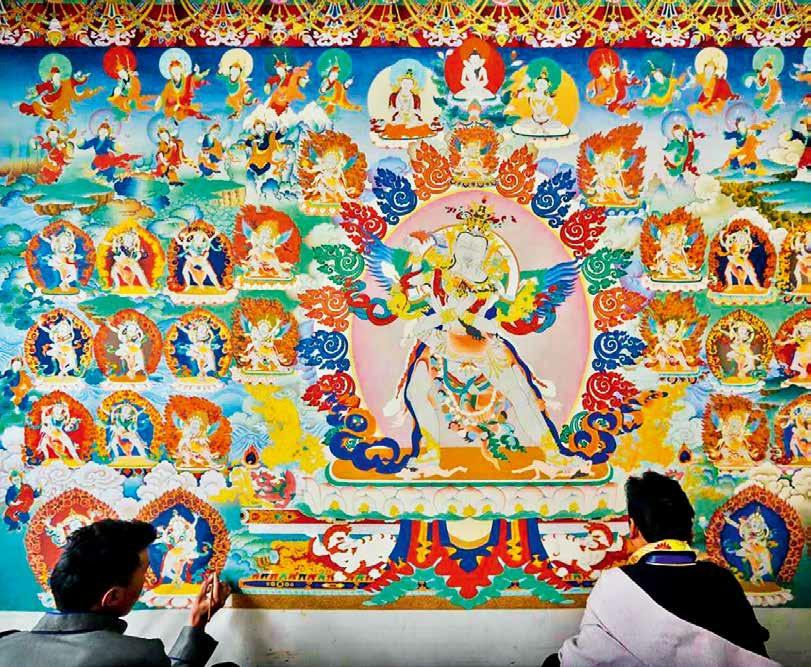Art Worth Worshiping
2020-09-30byKhamKelsangYeshe
by Kham Kelsang Yeshe

Thangka is a unique painting art and a religious instrument of Tibetan Buddhism. It captures the distinctive characteristics of Tibets rich religious tradition and regional artistic style. Thangka has long been treasured by Tibetan people. Its influence is even greater than that of local murals and sculptures. This painting art is widely used throughout Tibetan society. In every hall of monasteries in Tibetan areas, big and small, thangka paintings are a required component of Buddhist activities, favorites for display, and solemn tools for worship. They often become the representative treasures of temples with thousands of pieces. Thangka has been recognized as intangible cultural heritage by UNESCO.
Most Tibetan people follow Tibetan Buddhism. Religious activities are a major part of Tibetan lives. Their traditional religious culture has been honed for ages and now dominates their daily lives on the plateau. The relationship between the history of Tibet and the spread of religious belief and culture is tight. Even thangka paintings that record Tibetan history, culture, and science feature strong religious and humanistic flavor. Tibetans inhabit a snowy land, and they tend to explain social life through beliefs and cultural concepts. The art of thangka has become a visualized encyclopedia and spiritual food shared by all Tibetans thanks to its wide-ranging cultural and aesthetic features.
Truth, benevolence, and beauty represent the foundation of thangka art. Profound traditional Tibetan culture is a source of confidence among Tibetan people. The history of Tibetan art has its own clear definition, aesthetic connotations, and routes of development. In this regard, famous contemporary Tibetologist Tenzin Wangpo summed it up as excellent culture “based on the Bon culture, guided by Tibetan Buddhism, and absorbing the essence of cultures from surrounding areas.”
The Bon culture is the central culture of indigenous Tibetans as it has been on the plateau since ancient times. The belief system is characterized by animism, nature worship, offering of sacrifices, and pursuit for a harmonious life. The Bon culture is all about achieving harmonious development between people and nature, between society and people, and between people. Its most important values are harmony and peace, which are central. Tibetans regard the Bon culture as a harmonious way of genuine living.
Tibetan Buddhist culture is tightly related to Indian Buddhism, but Tibetans did not import the same Buddhism directly. Since Buddhism was introduced into Tibet, local masters have injected local traditional culture, religious beliefs, and Tibetan philosophies into the religion. Buddhist practices in Tibet kindled new understanding of Buddhism. Tibetans regard Tibetan Buddhist culture as a culture of wisdom and benevolence.
Tibetan culture absorbed the essence of excellent cultures from adjacent areas and nations. It features openness and inclusiveness after continuously engaging in exchange with cultures from other areas. Tibetans regard their culture as an excellent culture of “beauty.” Traditional Tibetan culture has been hailed as a classic culture of truth, benevolence, and beauty, and thangka is seen as a vivid representation of those traits.
Exquisite painting skills drive inheritance of thangka art. The art enjoys a lofty status as a sacred instrument for religious practices. It has been inherited in different ways including art craft academies in temples, masters, families, workshops, and official professional painting academies. Regardless of the method of inheritance, learners are taught cultural content, plastic art, and painting skills. Their artistic accomplishment is ultimately captured in the lines, forms, and colors of their works. Line modeling is the key skill of Tibetan thangka painting.
Several themes seen in thangka paintings have greatly facilitated the spread of the art. Thangka paintings can cover topics from astronomy and geography to natural sciences and humanities. Potential subject matters are nearly wide open, and the practice has been hailed as an “encyclopedia of Tibetan traditional culture.” The spread of culture through thangka has been documented in Buddhist scriptures, Buddhist history, and Tibetan culture, teaching, rituals, and art.
Thangka spreads Tibetan culture in the form of images. It recounts lives from different generations and expresses the unremitting spiritual pursuits and cultural inheritance of the Tibetan ethnic group. Thangka helps publicize the history of the Tibetan people and their scientific and technological knowledge. There is a type of thangka called “sman thang.” It is primarily used for spreading Tibetan medical knowledge, functioning similarly to diagrams used in Western medical schools. Well-known painter Lhozhag Tenzin Norbu painted 79 “sman thang” paintings which accurately depicted thousands of objects and outlined the basics of Tibetan medicine comprehensively and precisely. His works continue to play a major role in understanding and spreading Tibetan medical knowledge.